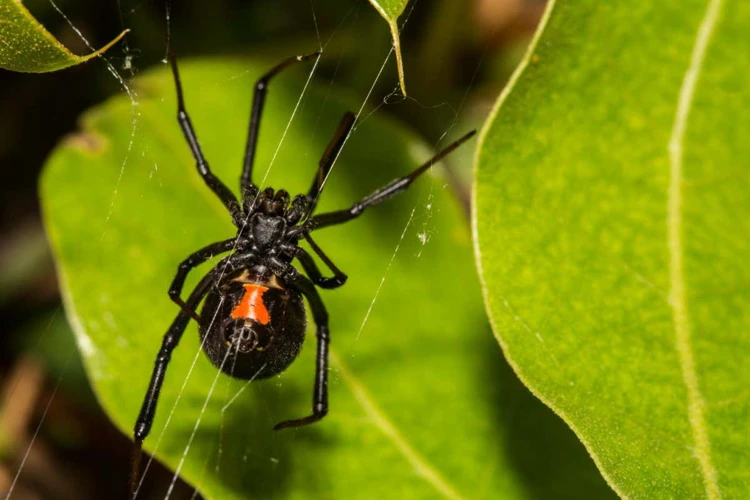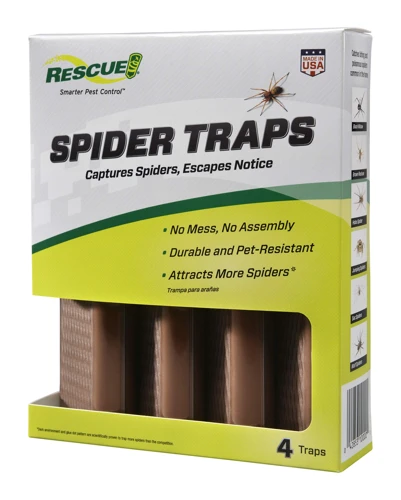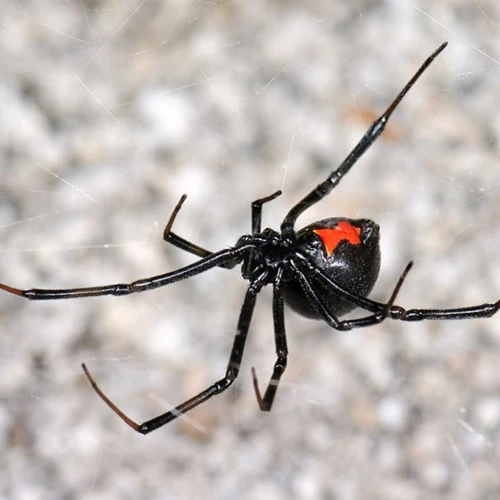Have you ever spotted a black widow spider in your home or yard? These venomous arachnids can certainly be frightening, and taking steps to trap and remove them is essential for your safety. But chemical pesticides can come with a range of undesirable side effects, from harming non-target species to contaminating your home environment. Instead, why not try making your own black widow spider traps? With just a few materials and some careful preparation, you can effectively remove these spiders while minimizing risks to yourself and the environment. In this guide, we’ll explore how to make your own black widow spider traps step-by-step, giving you the confidence to tackle this challenging task with ease.
Why Trapping Black Widow Spiders is Important

It’s essential to be aware of the significant threats black widow spiders pose to our well-being, including severe health conditions such as muscle aches, nausea, and spasms. As such, it is crucial to take appropriate measures to get rid of these dangerous spiders. While hiring professional spider removal services can be one solution, it can be costly and unnecessary for those who want to take matters into their own hands. In this article, we will examine how to DIY trap black widow spiders and offer effective solutions for keeping them out of your home.
Potential Dangers of Black Widow Spiders
Black widow spiders are a common household pest that can be a danger to you and your family. They are known for their venom, which is considered to be one of the most toxic in the world. The venom can be especially dangerous for children, the elderly, and those with weakened immune systems. Common symptoms of a black widow spider bite include severe pain, muscle cramps, and spasms, as well as nausea and vomiting. In rare cases, the venom can even lead to death.
While chemical pesticides are often used to control black widow spider populations, they come with their own set of dangers. These pesticides can be harmful to pets and children, as well as the environment. Additionally, they are not always effective and may not completely eliminate the spider population.
Using black widow spider traps is a much safer and more effective way to control these pests. By using traps made with non-toxic materials, you can safely and effectively reduce the number of black widow spiders in your home or yard. Traps are also more effective because they can be placed in specific areas where black widow spiders are known to be active, ensuring they are caught and removed.
There are many different types of traps that you can make at home with simple materials. Some popular examples include glue boards, which use a sticky adhesive to trap spiders, and DIY traps made with empty containers and a bait. You can find more information on these trapping methods and others at TRAPYOURSPIDERS.com.
If you are dealing with a severe black widow spider infestation, it may be worth considering professional spider removal services. These services can identify the source of the infestation and safely remove the spiders from your home. They can also provide tips on how to seal off entry points to prevent future infestations. You can learn more about professional spider removal services and their costs at TRAPYOURSPIDERS.com.
Disadvantages of Chemical Pesticides
Chemical pesticides are a common solution for getting rid of black widow spiders. However, using chemicals to eliminate these spiders can have negative effects on both human health and the environment. Some of the disadvantages of using chemical pesticides for black widow spiders include:
- Harmful toxins: Chemical pesticides contain harsh chemicals that can be harmful to humans and pets if ingested or inhaled. Exposure to these toxins can lead to serious health problems such as respiratory issues or poisoning.
- Environmental damage: Chemical pesticides can also cause damage to the environment. When sprayed outdoors, the chemicals can be harmful to plants and animals, as well as disrupt the ecosystem.
- Resistance: Overuse of chemical pesticides can lead to resistance to certain chemicals. Black widow spiders can build up resistance to chemical pesticides, making them harder to eliminate over time.
- Cost: Chemical pesticides can also be expensive. It can be more cost-effective to use other methods for trapping or preventing black widow spiders from entering your home.
While chemical pesticides may be a quick and easy solution for eliminating black widow spiders, it is important to consider the potential negative effects of using them. There are other effective methods such as using glue boards or making your own traps that do not involve harmful chemicals and are cost-effective.
Making Your Own Black Widow Spider Traps

For those who are looking for a DIY solution to combat black widow spiders, making your own trap can be an effective and cost-efficient option. By using simple materials and following easy steps, you can protect your home from the potential dangers of black widow spiders. In this section, we will guide you step-by-step on how to make your own black widow spider traps, so you can gain peace of mind knowing that you have a defense against these venomous arachnids. But first, let’s take a look at the materials you will need to make your own trap.
Materials You Will Need
To make a black widow spider trap, you will need a few materials, all of which can be found at your local hardware store. Here’s what you’ll need:
- Empty plastic containers with lids: These can be reused food containers or storage containers. Make sure they have a lid that can be securely fastened.
- Utility knife or scissors: You’ll use this to cut holes in the container.
- Strong glue: You’ll need a strong adhesive to attach the bait to the inside of the container and attach the container to the ground.
- Bait: This can include crickets, cockroaches or any other small insect that is attracted to black widow spiders.
- Small stones or pebbles: These will be used to weigh down the container and prevent black widow spiders from escaping.
It’s important to set up multiple traps in areas where black widow spider activity has been observed or where they are more likely to be found. This increases the chances of catching the spiders before they can cause harm. Once you have all the necessary materials, it’s time to move on to the next step: creating your black widow spider trap. For a step-by-step guide on how to do this, refer to the following section: Trapping Black Widow Spiders: Indoor and Outdoor Solutions.
Step-by-Step Guide for Trapping Black Widow Spiders
Trapping black widow spiders can be done using a few items that can easily be found around the house. The following table outlines a step-by-step guide to making and setting up black widow spider traps:
| Step | Instructions |
|---|---|
| Step 1 | Gather Materials: You will need cardboard, scissors, tape, a marker, and black widow spider bait. |
| Step 2 | Cut Cardboard: Cut the cardboard into strips and fold into a small rectangular box. Tape the sides together. |
| Step 3 | Create Entry Points: Using scissors, cut two holes into the sides of the rectangular box. These entry points should be big enough for the spider to crawl through. |
| Step 4 | Add Bait: Apply black widow spider bait onto a small piece of paper (such as a sticky note) and place it inside of the box trap. |
| Step 5 | Place Trap in Strategic Location: Place the trap in areas where black widow spiders are commonly found. These areas typically include dark and humid locations like basements, garages, and attics. |
| Step 6 | Check and Dispose of Traps: Check the traps regularly and dispose of any trapped spiders. If there are many black widow spiders in the home, consider calling a pest control professional. |
Remember, using traps is just one way to control black widow spiders. Natural methods, chemicals, and essential oils can also be effective. Combine different methods to find what works best for your home.
Preventing Black Widow Spiders in Your Home
Keeping black widow spiders out of your home is essential in preventing potential danger. With their venomous bite, it’s best to avoid these spiders altogether. While trapping is effective for those already inside, preventing their entry should be a top priority. In this section, we’ll go over some tips for keeping your home spider-free. From sealing entry points to choosing the best bait for trapping black widows, we’ll cover everything you need to know to keep your family safe.
Tips for Keeping Spiders Out
To keep black widow spiders out of your home, there are a few tips that can be helpful. Take note of these preventive measures to reduce the risk of an infestation.
- Seal all entry points: Black widow spiders can enter through small gaps and cracks in your doors, windows, and walls. Inspect your home for such gaps, and seal them using caulk and weatherstripping. This can effectively prevent spiders from infiltrating your space. If needed, use a black widow entry point sealing kit for thorough sealing.
- Declutter regularly: Black widows like to hide in cluttered spaces, so it’s crucial to keep your home organized and tidy. Get rid of old newspapers, cardboard boxes, and other debris that can become breeding grounds for spiders.
- Reduce outdoor lighting: Bright lights attract insects, and where there are insects, there are spiders. Consider installing low-light outdoor fixtures or motion-sensor lights to reduce the presence of insects in your yard.
- Store firewood away from your home: Firewood piles and other debris make for ideal hiding spots for spiders. Store your firewood at least 20 feet away from your home, and place it on a raised platform to prevent spiders from nesting in it.
- Install screens on doors and windows: Screens can provide an extra layer of protection against insects and spiders. Make sure they do not have any holes or tears that would allow pests to enter.
By following these tips, you can significantly reduce the likelihood of a black widow spider infestation in your home. These preventative measures can be effective in keeping spiders at bay without the need for using pesticides. However, if an infestation does occur, you may need to use traps or baits to eliminate the spiders. For more information on black widow solutions, check out our other articles.
Signs of Spider Infestation to Be Aware Of
It’s important to be aware of the signs of a black widow spider infestation in your home. These spiders are typically found in dark, secluded areas such as garages, basements, and attics. Here are some signs to look out for:
| Signs of Black Widow Spider Infestation |
|---|
| Webbing: Black widow spider webs are irregularly shaped, tangled webs that may include a funnel-like entrance. |
| Egg sacs: Black widow spiders lay their eggs in round, papery sacs that are about the size of a quarter. These sacs may be found in dark corners or crevices. |
| Live spiders: If you see black widow spiders in your home, it’s likely that there are more nearby. These spiders are not social and only come together during mating season. |
| Dead insects: Black widow spiders feed on insects and other arthropods. If you find a lot of dead insects in your home, it may indicate a spider infestation. |
If you notice any of these signs, it’s important to take action to prevent the infestation from getting worse. One option is to use glue boards to trap the spiders. Check out our guide on how to use glue boards to trap black widow spiders for more information. Another option is to use the best baits for trapping black widows. Learn more about the best baits for trapping black widows.
Conclusion
In conclusion, trapping black widow spiders is a simple and effective way to combat these dangerous pests in your home. By using DIY traps, you can avoid the potential dangers of chemical pesticides while still keeping your home safe from spider infestations.
Remember to always exercise caution when dealing with black widow spiders, as they can be extremely dangerous. However, with the tips and techniques described in this article, you can take the necessary precautions to prevent these spiders from entering your home.
It is also important to note that prevention is key when it comes to spider infestations. By following the tips outlined in this article for keeping spiders out of your home, you can greatly reduce the likelihood of encountering black widow spiders or other spiders.
Overall, DIY trapping is a practical and affordable solution for dealing with black widow spiders. With the right materials and techniques, you can create effective traps that will safely capture these pests and prevent them from causing harm in your home. By taking action now, you can protect yourself and your family from the potential dangers associated with black widow spiders.
Frequently Asked Questions
1. Can black widow spiders be found in all regions of the United States?
While black widow spiders are most commonly found in the southern and western regions of the United States, they can be present in other areas as well.
2. What do black widow spider eggs look like?
Black widow spider eggs are typically housed in a small white egg sac and can contain around 200 eggs.
3. How long does it take for black widow spider eggs to hatch?
Black widow spider eggs typically hatch within two to four weeks.
4. What do black widow spiders eat?
Black widow spiders primarily eat insects, but they are known to also consume other spiders and small animals if necessary.
5. How poisonous are black widow spiders?
Black widow spiders possess a powerful venom that can cause symptoms such as muscle pain, spasms, and cramps. While their bites can be dangerous, deaths from black widow spider bites are rare.
6. What is the best time to trap black widow spiders?
It is best to trap black widow spiders during the night when they are most active and searching for food.
7. Where is the best location to place black widow spider traps?
The best location to place black widow spider traps is near their hiding places, such as dark corners or crevices.
8. Can black widow spiders be deterred with natural remedies?
While there are no proven natural remedies to completely eliminate black widow spiders, some people suggest using essential oils or vinegar to deter them.
9. How do I properly dispose of trapped black widow spiders?
To properly dispose of trapped black widow spiders, place them in a sealed container and dispose of them in a trash can outside of your home.
10. Is regular cleaning an effective way to prevent black widow spiders?
Regular cleaning and decluttering can help prevent black widow spiders by eliminating places where they could potentially hide.






